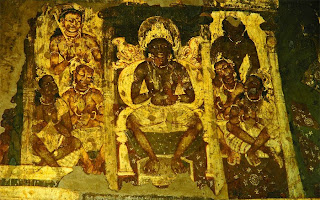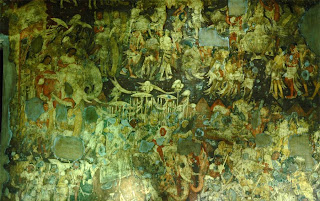HOW PAINTINGS WERE DONE IN THE DARK CAVES?
It is thought that the craftsmen who painted and sculpted in the Ajanta caves, were mostly Buddhist monks Perhaps many Hindu craftsmen of the lower castes had accepted the faith of the Buddha, the Craftsmen, in those days, were grouped together according to their profession, they learnt their skill from father to son and son to son. Some of them were great masters, who invented new techniques new tools and new ways of handling paint and chisel, in every generation.As the Buddhists began to scoop caves from the 1st century A.D. downwards, they evolved practical ways of working in the dark. The marshal, or stick torch, was smeared with vegetable oil and used for lighting dark corners. Also, large mirrors were used to reflect sunshine in to the interiors. And the walls were whitewashed smeared with lime plaster, before painting.
HOW PAINTS WERE MADE?
HOW PAINTS WERE MADE?
Colors used for the wall paintings were made from pebbles and vegetable found on the hillside. The guide will show you the pebbles of different Colors, these were crushed and ground and the mixed with glue.The main colors used were; red ochre, yellow ochre, brown ochre, lamp black, white and lapis lazuli (blue). This last pigment was imported from Northern India, central Asia and Persia. Green was made by mixed this lapis lazuli with Indian yellow ochre.
TECHNIQUES OF MAKING WALL PAINTINGS:
TECHNIQUES OF MAKING WALL PAINTINGS:
The Indian wall painting technique is different from that of the fresco of the West. A layer of clay was mixed with cow dung and powdered rice hunk. This was first applied to the chipped rock surface. When it dries, a second coat of lime plaster was a trowel. The lines were then drawn in pink, brown or black; the colors were filled in with big brushes, made from the hair of squirrel’s tail. I am posting some pictures of paintings taken by me when I visited Ajanta in April 2009.
















4 comments:
Amazing photographs ... and very informative.
Kya baat hai....!!!A Comment from you is real pleasant surprise....many thanks... :)
Hi,
This is a wrong statement: many Hindu craftsmen of the lower castes had accepted the faith of the Buddha,
No, this is not true because many royal families had adopted Buddhism as their religion. Many Sanskrit scholars were followed Buddha region.
Pls check Wiki.
Many Thanks,
Dr. Rama
Post a Comment